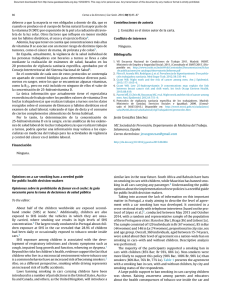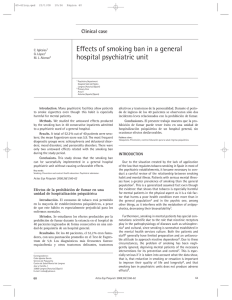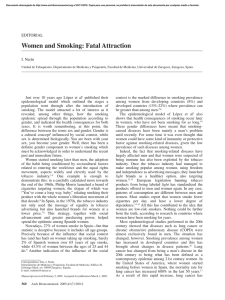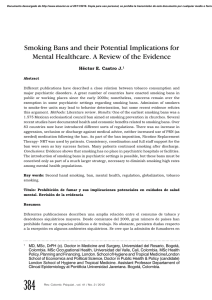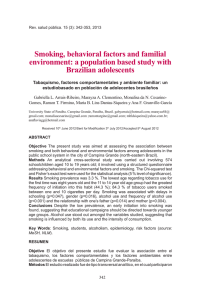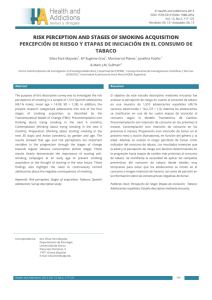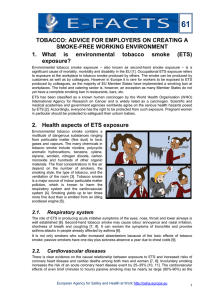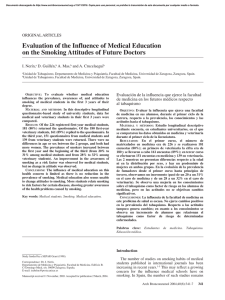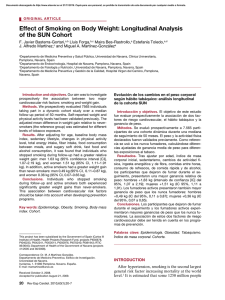deberse a que la mayoría se ven obligados a dormir de día, que es
Anuncio
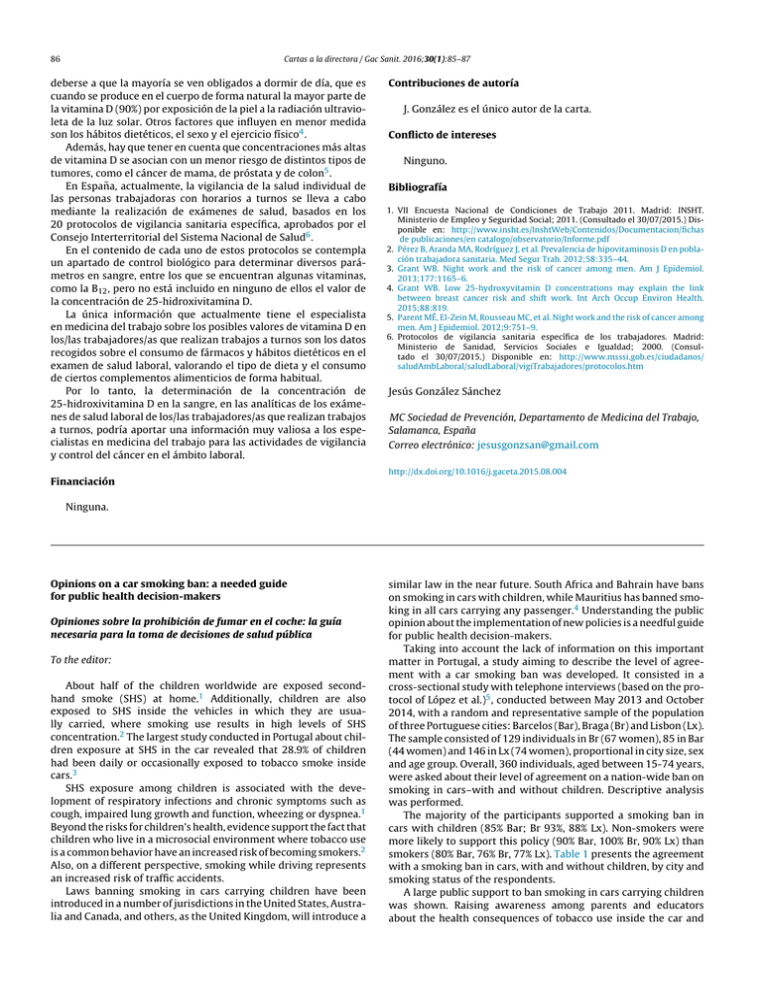
86 Cartas a la directora / Gac Sanit. 2016;30(1):85–87 deberse a que la mayoría se ven obligados a dormir de día, que es cuando se produce en el cuerpo de forma natural la mayor parte de la vitamina D (90%) por exposición de la piel a la radiación ultravioleta de la luz solar. Otros factores que influyen en menor medida son los hábitos dietéticos, el sexo y el ejercicio físico4 . Además, hay que tener en cuenta que concentraciones más altas de vitamina D se asocian con un menor riesgo de distintos tipos de tumores, como el cáncer de mama, de próstata y de colon5 . En España, actualmente, la vigilancia de la salud individual de las personas trabajadoras con horarios a turnos se lleva a cabo mediante la realización de exámenes de salud, basados en los 20 protocolos de vigilancia sanitaria específica, aprobados por el Consejo Interterritorial del Sistema Nacional de Salud6 . En el contenido de cada uno de estos protocolos se contempla un apartado de control biológico para determinar diversos parámetros en sangre, entre los que se encuentran algunas vitaminas, como la B12 , pero no está incluido en ninguno de ellos el valor de la concentración de 25-hidroxivitamina D. La única información que actualmente tiene el especialista en medicina del trabajo sobre los posibles valores de vitamina D en los/las trabajadores/as que realizan trabajos a turnos son los datos recogidos sobre el consumo de fármacos y hábitos dietéticos en el examen de salud laboral, valorando el tipo de dieta y el consumo de ciertos complementos alimenticios de forma habitual. Por lo tanto, la determinación de la concentración de 25-hidroxivitamina D en la sangre, en las analíticas de los exámenes de salud laboral de los/las trabajadores/as que realizan trabajos a turnos, podría aportar una información muy valiosa a los especialistas en medicina del trabajo para las actividades de vigilancia y control del cáncer en el ámbito laboral. Contribuciones de autoría J. González es el único autor de la carta. Conflicto de intereses Ninguno. Bibliografía 1. VII Encuesta Nacional de Condiciones de Trabajo 2011. Madrid: INSHT. Ministerio de Empleo y Seguridad Social; 2011. (Consultado el 30/07/2015.) Disponible en: http://www.insht.es/InshtWeb/Contenidos/Documentacion/fichas de publicaciones/en catalogo/observatorio/Informe.pdf 2. Pérez B, Aranda MA, Rodríguez J, et al. Prevalencia de hipovitaminosis D en población trabajadora sanitaria. Med Segur Trab. 2012;58:335–44. 3. Grant WB. Night work and the risk of cancer among men. Am J Epidemiol. 2013;177:1165–6. 4. Grant WB. Low 25-hydroxyvitamin D concentrations may explain the link between breast cancer risk and shift work. Int Arch Occup Environ Health. 2015;88:819. 5. Parent MÉ, El-Zein M, Rousseau MC, et al. Night work and the risk of cancer among men. Am J Epidemiol. 2012;9:751–9. 6. Protocolos de vigilancia sanitaria específica de los trabajadores. Madrid: Ministerio de Sanidad, Servicios Sociales e Igualdad; 2000. (Consultado el 30/07/2015.) Disponible en: http://www.msssi.gob.es/ciudadanos/ saludAmbLaboral/saludLaboral/vigiTrabajadores/protocolos.htm Jesús González Sánchez MC Sociedad de Prevención, Departamento de Medicina del Trabajo, Salamanca, España Correo electrónico: [email protected] http://dx.doi.org/10.1016/j.gaceta.2015.08.004 Financiación Ninguna. Opinions on a car smoking ban: a needed guide for public health decision-makers Opiniones sobre la prohibición de fumar en el coche: la guía necesaria para la toma de decisiones de salud pública To the editor: About half of the children worldwide are exposed secondhand smoke (SHS) at home.1 Additionally, children are also exposed to SHS inside the vehicles in which they are usually carried, where smoking use results in high levels of SHS concentration.2 The largest study conducted in Portugal about children exposure at SHS in the car revealed that 28.9% of children had been daily or occasionally exposed to tobacco smoke inside cars.3 SHS exposure among children is associated with the development of respiratory infections and chronic symptoms such as cough, impaired lung growth and function, wheezing or dyspnea.1 Beyond the risks for children’s health, evidence support the fact that children who live in a microsocial environment where tobacco use is a common behavior have an increased risk of becoming smokers.2 Also, on a different perspective, smoking while driving represents an increased risk of traffic accidents. Laws banning smoking in cars carrying children have been introduced in a number of jurisdictions in the United States, Australia and Canada, and others, as the United Kingdom, will introduce a similar law in the near future. South Africa and Bahrain have bans on smoking in cars with children, while Mauritius has banned smoking in all cars carrying any passenger.4 Understanding the public opinion about the implementation of new policies is a needful guide for public health decision-makers. Taking into account the lack of information on this important matter in Portugal, a study aiming to describe the level of agreement with a car smoking ban was developed. It consisted in a cross-sectional study with telephone interviews (based on the protocol of López et al.)5 , conducted between May 2013 and October 2014, with a random and representative sample of the population of three Portuguese cities: Barcelos (Bar), Braga (Br) and Lisbon (Lx). The sample consisted of 129 individuals in Br (67 women), 85 in Bar (44 women) and 146 in Lx (74 women), proportional in city size, sex and age group. Overall, 360 individuals, aged between 15-74 years, were asked about their level of agreement on a nation-wide ban on smoking in cars–with and without children. Descriptive analysis was performed. The majority of the participants supported a smoking ban in cars with children (85% Bar; Br 93%, 88% Lx). Non-smokers were more likely to support this policy (90% Bar, 100% Br, 90% Lx) than smokers (80% Bar, 76% Br, 77% Lx). Table 1 presents the agreement with a smoking ban in cars, with and without children, by city and smoking status of the respondents. A large public support to ban smoking in cars carrying children was shown. Raising awareness among parents and educators about the health consequences of tobacco use inside the car and Cartas a la directora / Gac Sanit. 2016;30(1):85–87 Table 1 Agreement with a smoking ban in cars, with and without children, by city and smoking status of the respondents. Agreement with a smoking ban in cars N With children n (%) Without children n (%) Non-smoker Barcelos Braga Lisboa 77 91 115 69 (89.6) 91 (100.0) 103 (90.4) 68 (88.3) 82 (90.1) 63 (54.8) Smoker Barcelos Braga Lisboa 8 38 31 6 (75.0) 29 (76.3) 24 (77.4) 5 (62.5) 13 (34.2) 8 (25.8) encouraging them not to smoke indoors is an urgent need to promote smoke-free cars. Mainly, a ban on smoking inside cars would have immediate impacts on children’s health protection. Results from this study strengthens the call for policy-makers to implement strategies to protect this fragile group, starting by banning tobacco use inside vehicles while carrying children. Funding This study was supported through FEDER from the Operational Programme Factors of Competitiveness–COMPETE and through national funding from the Foundation for Science and Technology–FCT (Portuguese Ministry of Education and Science) (FCOMP-01-0124-FEDER-009117). Statement of authorship Acknowledgments The authors gratefully acknowledge all the participants in the study. Bibliografía 1. WHO - World Health Organization. WHO Report on the Global Tobacco Epidemic: implementing smoke-free environments. Geneva: World Health Organization; 2009. 2. USDHHS-U.S. Department of Health and Human Services. The health consequences of involuntary exposure to tobacco smoke: a report of the surgeon general. Atlanta, GA: U.S. Department of Health and Human Services; 2006. 3. Vitória PD, Machado JC, Ravara SB, et al. Portuguese children’s exposure to secondhand tobacco smoke in the family car. Gac Sanit. 2015;29:131–4. 4. Canadian Cancer Society. Laws banning smoking in cars with children – international overview. 2014. [Consulted on 14/04/2015]. Available at: http://www.ash.org.uk/files/documents/ASH 909.pdf. 5. López MJ, Schiaffino A, Pérez-Ríos M, et al. Opiniones sobre la prohibición de fumar en espacios exteriores tras la ley de control del tabaquismo de 2011 (ley 42/2010). In: Congreso Iberoamericano de Epidemiología y Salud Pública; 4 September 2013. Granada, Spain. Gaceta Sanitaria; 2013; p.125. José Precioso a,∗ , Fátima Reis b , Isabel Sousa a , Carla Sousa b , José Machado c , Luís Dias a , Catarina Samorinha d , Henedina Antunes e a Instituto de Educação, Universidade do Minho, Braga, Portugal Instituto de Saúde Ambiental, Instituto de Medicina Preventiva e Saúde Pública, Faculdade de Medicina da Universidade de Lisboa, Lisboa, Portugal c Instituto de Ciências Sociais, Universidade do Minho, Braga, Portugal b d EPIUnit - Instituto de Saúde Pública da Universidade do Porto, Porto, Portugal e Serviço de Pediatria, Hospital de Braga; Instituto de Ciências da Vida e da Saúde (ICVS); Escola de Ciências da Saúde da Universidade do Minho e Laboratório associado ICVS/3B’s, Braga/Guimarães, Portugal The study was designed by J. Precioso, F. Reis and J. Machado. J. Precioso and L Dias wrote the first draft of the manuscript. I. Sousa and C. Sousa collected the data. J. Precioso and J. Machado designed and carried out statistical analysis. All authors gave a substantial contribution to the interpretation of data, critical discussion and revision of the manuscript, and approved its final version. ∗ Corresponding author. E-mail address: [email protected] (J. Precioso). Conflicts of Interest http://dx.doi.org/10.1016/j.gaceta.2015.08.001 None. 87
